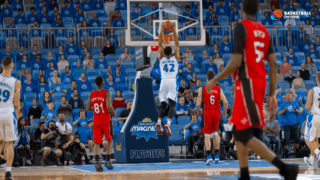
How Much Height Do Basketball Shoes Add?
Written by: Basketball Universe
Last updated:

If you’ve ever found yourself curious about lacing up your sneakers to gain a little extra elevation on the court, you’re not alone. Many hoopsters have wondered just how much height they stand to gain with a stylish pair of basketball shoes. In this blog post, we’re set to explore the fascinating world of basketball footwear and delve deep into the question: “How much height do basketball shoes add?” So, jump in with both feet, as we unravel the vertical mysteries of basketball shoe design, debunk common myths, and discover how to elevate your game in more ways than one.
How Much Height Do Basketball Shoes Add?
On average, basketball shoes add approximately 1-1.5 inches (2.54-3.81 cm) to a player’s height. The exact amount varies based on the design, midsole thickness, and outsole composition of the shoe. High-performance shoes may focus more on support, cushioning, and stability, while casual models might prioritize aesthetics and height gain. Keep in mind that individual shoe models and brands can have different height-increasing effects, so it’s best to try on a specific pair to determine how much height it adds for you.
Understanding the Shoe Anatomy
Before diving into the specifics of height addition, it’s essential to understand the different components of a basketball shoe. Most shoes consist of an upper, midsole, and outsole, each serving a unique purpose.
The Upper
The upper is the top part of the shoe that wraps around the foot and provides a snug fit. It is usually made of lightweight and breathable materials to ensure comfort and durability. Uppers come in various styles, from high-tops that offer increased ankle support to low-tops, which prioritize flexibility and freedom of movement. Depending on the upper design, a shoe might add minimal height, if any, in this section.
The Midsole
The midsole is the middle part of the shoe, located between the upper and the outsole. It is responsible for providing cushioning, shock absorption, and support while walking, running or jumping. Midsole materials vary across basketball shoe models, with some featuring gel, air, or foam-based technologies. This is where most of the height is added to a basketball shoe, as it determines the elevation from the ground to the foot.
The Outsole
The outsole consists of the bottom part of the shoe that makes contact with the ground. It is typically made of durable rubber material and features various patterns for optimal traction and grip on the court. The outsole contributes slightly to the overall height of a basketball shoe, but its primary purpose is to enhance performance and prevent slips or falls.
Common Basketball Shoe Technologies that Add Height
Over the years, several shoe technologies have emerged, aiming to enhance comfort, support, and performance on the court. Some of these technologies contribute to the overall height of basketball shoes:
Air Cushioning
Popularized by Nike’s ‘Air’ series, air cushioning is a lightweight, pressurized system that absorbs shock and provides responsive cushioning. The air units used in these shoes can add height, depending on their size and placement. Shoes featuring visible air units, such as the Air Max lineup, significantly increase the shoe’s stature, adding an extra 0.5-1 inches (1.27-2.54 cm) of height.
Zoom Air
Another cushioning technology from Nike, Zoom Air comprises specially designed air-filled pockets that provide excellent energy return and increased responsiveness. While they offer a thinner cushioning compared to the traditional air cushioning, Zoom Air units can still contribute to the overall height of a basketball shoe, usually adding a few millimeters.
Boost Foam
Adidas introduced Boost foam as a revolutionary cushioning system for basketball shoes. Made of thermoplastic polyurethane (TPU) pellets, Boost foam is lightweight, comfortable, and offers a superior energy return. Shoes equipped with Boost technology feature a thicker midsole, contributing to an increased overall height of up to 1 inch (2.54 cm).
Curved Soles
Curved soles are designed to promote a more comfortable and natural stride. Brands like Under Armour and Puma have adopted this technology to enhance performance in their basketball shoe lines. The curvature of the sole can slightly increase the height of a shoe, although the impact on the overall height is generally minimal.
Factors that Affect Height Addition
As mentioned earlier, the amount of height a basketball shoe adds varies between different models and brands. Keep in mind the following factors that might impact a shoe’s height-increasing potential:
Shoe Purpose
Performance-oriented shoes often prioritize support, fit, and stability over height addition. However, certain models do integrate cushioning technologies that may inadvertently provide an extra boost. On the other hand, casual or fashion-focused basketball shoes have more leeway to focus on design elements that add height, as performance is not their primary concern.
Shoe Design
Some basketball shoes feature unique design attributes that make them taller, such as thicker outsoles or chunkier midsole sections. However, certain shoe models might compromise height for performance benefits like court feel or lightweight construction.
Personal Factors
The amount of height a shoe adds can vary from individual to individual based on factors like foot size, arch height, or choice of insoles. Choosing the right socks or insoles, for example, can make a notable difference in how much height a basketball shoe adds for you specifically.
Maximizing Your Height with Basketball Shoes
Whether you’re looking to gain an extra height advantage on the court or simply level up your sneaker game, here are some tips on maximizing the height potential of basketball shoes:
Select a High-Top Design
High-top basketball shoes provide more ankle support, but they also tend to have thicker outsoles than their low-top counterparts. This additional height in the outsole could give you a slight edge when it comes to added elevation.
Opt for Cushioning Technologies
As mentioned earlier, certain cushioning technologies, like air cushioning, Boost foam, or Zoom Air, can contribute to added height in a basketball shoe. Keep an eye out for these cushioning systems when selecting your sneakers.
Insert Insoles or Heel Lifts
Using inserts or heel lifts can help you gain an extra inch or two in height while still enjoying the comfort of your basketball shoes. However, it’s essential to select the right inserts for your shoe model to ensure a comfortable fit and avoid compromising performance or stability on the court.
The Height Debate: Does it Really Matter?
The importance of height in basketball has always been a subject of discussion. Despite the seemingly crucial role it plays, it’s crucial to remember that basketball is a game of skill and perseverance. Legendary players like Muggsy Bogues and Isaiah Thomas have proven that size isn’t everything when it comes to success on the court. While having a pair of shoes that can contribute an extra inch or two might provide a brief confidence boost, ultimately, it’s your skills, effort, and dedication to the game that will set you apart from the competition.
Final Words: Choose Wisely, Play Better
In summary, basketball shoes typically add around 1-1.5 inches (2.54-3.81 cm) of height for a player. Various factors can impact this addition, from shoe design and cushioning technologies to individual preferences and fit. While a little extra elevation might come in handy during games, remember that your skills and hard work are what will truly elevate your performance on the court.
Finding the Perfect Basketball Shoe for You
With so many basketball shoe options available on the market, selecting the right pair can seem overwhelming. Aside from height addition, there are numerous factors to consider when finding the perfect basketball shoe for your needs. Here are some essential elements to take into account:
Comfort and Fit
Ensuring that your basketball shoes are comfortable and fit correctly is vital for performance on the court. Shoes that are too tight or too loose can hinder your movement or cause discomfort during play. When selecting a basketball shoe, be sure to try them on with your usual basketball socks and consider any insoles or orthotics that you may wear.
Support and Stability
Different players require varying levels of support based on their playing style, position, and personal preference. High-top shoes typically provide more ankle support, while low-top shoes offer better flexibility and freedom of movement. Some players may opt for mid-top shoes, which provide a balanced level of support between the two. Look for features like padded collars, secure lacing systems, or straps for added support and stability.
Traction
Good traction can make a substantial difference in your game, preventing slips and falls while allowing for quick changes in direction. Look for a basketball shoe with a durable outsole and a traction pattern that suits your playing surface – whether you play indoors or outdoors. Herringbone patterns are a popular and effective choice for most court surfaces.
Durability
Given the dynamic nature of basketball, it’s crucial to invest in a shoe that can withstand the wear and tear of regular play. Durable materials and reinforced high-wear areas can help extend the lifespan of your basketball shoes. Keep in mind that higher-quality materials and construction might come with a higher price tag but often last longer in the long run.
Style and Personal Preferences
While performance should be the primary focus when choosing a basketball shoe, it’s essential to feel confident and proud of your kicks on the court. Choose a design, colorway, or signature model that resonates with your personality and complements your basketball gear.
Understanding the Impact of Height on Performance
Though we’ve focused primarily on the height addition provided by basketball shoes, it’s worth noting how height can impact various aspects of a player’s game:
Rebounding
Increased height can give players an advantage when competing for rebounds, providing better access to snatch the ball mid-air. In addition to shoe height, vertical leap and arm length can also play a significant role in a player’s rebounding ability.
Shot Blocking
Taller players have a better chance of blocking opponents’ shots, as they can reach higher and come closer to the ball’s trajectory. However, shot blocking is not solely based on height—timing, athleticism, and anticipation are also crucial factors.
Shooting
While taller players might have an advantage in shooting over opponents, height is less important than skill level and shooting technique. Players of all heights can become exceptional shooters by honing their mechanics and practicing extensively.
Ball Handling and Speed
Contrary to popular belief, being taller doesn’t necessarily mean being slower or less agile on the court. Players of various heights can possess exceptional ball-handling and speed abilities—key attributes to success in the game.
Ultimately, it’s important to remember that basketball is a multifaceted game requiring a diverse skill set. Height isn’t the defining factor in basketball success, and players can excel in numerous ways regardless of height. With the right combination of dedication, talent, and heart, any player can make an impact on the court—whether they’re wearing basketball shoes that add an extra inch or two or not.
Frequently Asked Questions
Still curious about the world of basketball shoe height? Here’s a compilation of frequently asked questions to help quench your thirst for knowledge on this intriguing topic. Dive into these quick-fire answers to satisfy your curiosity and broaden your understanding of basketball footwear.
1. Do high-top shoes always add more height than low-top shoes?
Not necessarily. While high-top shoes may have thicker outsoles, contributing to added height, it’s the midsole that plays a more significant role in the vertical boost. High-top and low-top shoes can both have similar midsole designs, resulting in comparable height additions.
2. Can I increase the height of my basketball shoes without compromising performance?
Yes, you can add insoles or heel lifts to your basketball shoes for extra height. However, it’s essential to choose the right inserts to ensure proper fit and comfort, as some may affect stability or hinder performance on the court.
3. Does adding height to my basketball shoes improve my vertical leap?
While wearing shoes with a height boost can give you a slight advantage when jumping, it won’t significantly impact your vertical leap. Improving your vertical jump is more about building strength, power, and technique through targeted exercises and training.
4. Do NBA players use height-enhancing insoles or lifts in their shoes?
Some NBA players might use customized insoles or orthotics to address specific needs, such as foot support or comfort. However, it’s generally uncommon for players to use height-enhancing lifts, as performance and fit take precedence over added height in the professional arena.
5. How do I know if my basketball shoes fit correctly?
A proper-fitting basketball shoe should feel snug but comfortable, without any excessive pressure points or excessive space around your foot. Your toes should have adequate room to move without sliding around in the shoe, and your heel should be securely locked in place.
6. How often should I replace my basketball shoes?
The lifespan of a basketball shoe depends on factors like frequency of use, playing style, and shoe quality. Typically, basketball shoes should be replaced every six months to a year, or when you notice significant wear and reduced performance attributes, such as traction or cushioning.
7. What’s the best way to clean basketball shoes?
Use a clean, damp cloth or soft brush to gently remove dirt and stains from your basketball shoes. For more stubborn spots, a mild soap solution can be used. Avoid submerging shoes in water or placing them in a washing machine, as this can damage the materials and compromise their structural integrity.
8. Can I play basketball in running shoes or other sports shoes?
It’s not recommended to play basketball in running shoes or shoes designed for other sports, as they lack the necessary support, cushioning, and stability needed for the unique demands of basketball. Stick to footwear specifically designed for basketball to optimize performance and reduce the risk of injury.
9. Can I wear basketball shoes casually?
Yes, many basketball shoes double as stylish casual footwear. While wearing basketball shoes as everyday shoes might cause additional wear and tear, there’s no reason not to sport your favorite kicks off the court if you find them comfortable and fashionable.
10. Does a more expensive basketball shoe always mean higher quality?
Not always. While higher-priced shoes may feature more advanced technologies, better materials, or more elaborate designs, you can find quality options within a wide range of price points. Consider your specific needs and budget when selecting a basketball shoe rather than relying solely on price.
11. How do I know if a basketball shoe provides good traction?
Good traction is typically determined by the outsole’s material and the pattern of the treads. Look for durable rubber outsoles and versatile traction patterns, such as herringbone, to ensure optimal grip on a variety of court surfaces.
12. Are basketball shoes suitable for outdoor play?
Some basketball shoes are designed to withstand the rougher surfaces and conditions of outdoor play. Look for shoes with durable outsoles, reinforced uppers, and a traction pattern suitable for outdoor courts when choosing shoes for outdoor use.
13. How do I select the right shoe size when buying online?
When shopping online, refer to the brand-specific sizing chart and follow any guidelines provided to ensure proper fit. Additionally, consider any reviews or customer feedback relating to the fit of a particular
Featured Posts
- No pillar pages found.





